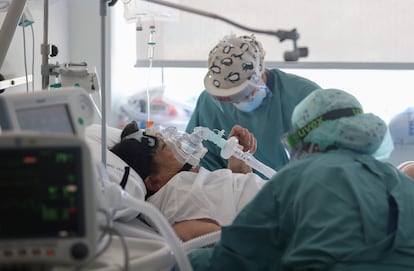The fifth wave of the coronavirus sees pressure on hospitals rise, with 370 new patients a day
The Health Ministry has reported 61,628 new cases since Friday, adding 23 Covid-19 victims to the overall death toll

Spain’s Health Ministry reported 61,628 new cases of coronavirus on Monday, and added 23 Covid-19 victims to the overall death toll. The data shows that this fifth wave of the pandemic continues to gain strength in Spain. The number of Covid-19 patients now stands at 6,482 – a rise of 1,426 since Friday. Of these, 1,039 are in intensive care units (ICUs), a figure that has gone up by 167 since Friday. On each one of the last seven days, the number of Covid-19 patients has risen an average of 370, and ICU patients by 46.
The 14-day cumulative number of coronavirus cases per 100,000 inhabitants now stands at 600, up 63 points from Friday. Catalonia is the Spanish region that tops the table for this data point, with 1,234. What’s more, Navarre and Castilla y León are also above 800 cases, while Aragón exceeds 700.
The data show that the rate of new cases has slowed slightly, having risen 63% in the last week compared to 80% the week before. Despite this slight improvement, the assistant director of the Health Ministry’s Coordination Center for Health Alerts (CCAES), María José Sierra, insisted on Monday that “cases continue to rise,” and that while three in every four people diagnosed with the coronavirus are under the age of 40, the incidence is going up “in all age groups.”
Hospitalizations and ICU admissions, which usually take a few weeks to go up after a rise in the incidence, continue to accelerate according to Monday’s report. In the last few days, the number of hospitalizations in Spain has grown 67% compared to the 43% rise the week before. Yesterday’s report showed 45% occupation of hospital beds by Covid-19 patients, and 17% in the ICUs. Sierra called these figures “worrying.”

“We are still in a very delicate moment and we should all be very concerned,” she said on Monday. “The virus is still widely circulating.” Again, Catalonia is suffering from the highest pressure on its healthcare system, with a third of its beds occupied by coronavirus patients.
The number of Covid-19 fatalities has also risen slightly, with 99 victims added to the statistics in the last seven days, a rise of 13 compared to the week before.
The fact that this fifth wave is likely to last another few weeks is also reflected in other statistics, such as the positivity (i.e. the percentage of diagnostic tests that come back positive). The average in Spain is 15.1%, although in Catalonia the figure exceeds 20% and in Navarre, Aragón and Castilla y León it is approaching those levels.
In terms of age groups, it is those aged 20-29 who are seeing a higher incidence, with 1,794 cases. But in Catalonia, Navarre, Castilla y León and Asturias, this figure exceeds 3,000. This means that nearly one in every 30 people aged between 20 and 29 has tested positive for the virus in the last 14 days. The second group with the highest rate of infections is that of adolescents aged 12 to 19 (1,488).
Despite the vast majority of the cases in these groups presenting either mild symptoms or being asymptomatic, the volume of infections is so high that ICU admissions are starting to be more frequent and there have even been some deaths. In Catalonia, for example, on Sunday there were 14 patients in their 20s and two adolescents in the ICU, while a 29-year-old Covid-19 patient died.
Healthcare chiefs are particularly concerned about a rise in the incidence among older groups, especially the nearly million people in Spain aged between 60 and 69 who are waiting to receive their second shot of the Oxford-AstraZeneca vaccine. A similar number of citizens aged 50 to 59 are also waiting for this injection. Studies published so far have shown that the vaccines being administered in Spain and across the European Union are equally effective against the virus, even the more-contagious delta variant, which is now dominant in most of Spain. But this research has also shown that the risk of hospitalization also rises when a person has only received the first dose of one of these two-shot vaccines.
In the last seven days, the incidence of the virus in the 60-69 group has risen from 112 cases to 232 per 100,000 inhabitants, and from 125 to 237 cases among the 50-59 age group.
English version by Simon Hunter.
Tu suscripción se está usando en otro dispositivo
¿Quieres añadir otro usuario a tu suscripción?
Si continúas leyendo en este dispositivo, no se podrá leer en el otro.
FlechaTu suscripción se está usando en otro dispositivo y solo puedes acceder a EL PAÍS desde un dispositivo a la vez.
Si quieres compartir tu cuenta, cambia tu suscripción a la modalidad Premium, así podrás añadir otro usuario. Cada uno accederá con su propia cuenta de email, lo que os permitirá personalizar vuestra experiencia en EL PAÍS.
¿Tienes una suscripción de empresa? Accede aquí para contratar más cuentas.
En el caso de no saber quién está usando tu cuenta, te recomendamos cambiar tu contraseña aquí.
Si decides continuar compartiendo tu cuenta, este mensaje se mostrará en tu dispositivo y en el de la otra persona que está usando tu cuenta de forma indefinida, afectando a tu experiencia de lectura. Puedes consultar aquí los términos y condiciones de la suscripción digital.
More information
Últimas noticias
Iranian women are also defying the taboo of riding motorcycles (and without a license)
David Bowie, the galactic thinker who encouraged us to break new ground
John Berger and the loss of rural culture
From police officer to bloodthirsty kidnapper: Terror in Mexico during the years of ‘The Ear Chopper’
Most viewed
- David King, chemist: ‘There are scientists studying how to cool the planet; nobody should stop these experiments from happening’
- Reinhard Genzel, Nobel laureate in physics: ‘One-minute videos will never give you the truth’
- Oona Chaplin: ‘I told James Cameron that I was living in a treehouse and starting a permaculture project with a friend’
- Mexico completes its trade shift with the entry into force of tariffs on China and countries without trade agreements
- Sinaloa Cartel war is taking its toll on Los Chapitos










































